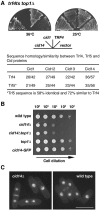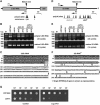Requirement of fission yeast Cid14 in polyadenylation of rRNAs
- PMID: 16478992
- PMCID: PMC1430263
- DOI: 10.1128/MCB.26.5.1710-1721.2006
Requirement of fission yeast Cid14 in polyadenylation of rRNAs
Abstract
Polyadenylation in eukaryotes is conventionally associated with increased nuclear export, translation, and stability of mRNAs. In contrast, recent studies suggest that the Trf4 and Trf5 proteins, members of a widespread family of noncanonical poly(A) polymerases, share an essential function in Saccharomyces cerevisiae that involves polyadenylation of nuclear RNAs as part of a pathway of exosome-mediated RNA turnover. Substrates for this pathway include aberrantly modified tRNAs and precursors of snoRNAs and rRNAs. Here we show that Cid14 is a Trf4/5 functional homolog in the distantly related fission yeast Schizosaccharomyces pombe. Unlike trf4 trf5 double mutants, cells lacking Cid14 are viable, though they suffer an increased frequency of chromosome missegregation. The Cid14 protein is constitutively nucleolar and is required for normal nucleolar structure. A minor population of polyadenylated rRNAs was identified. These RNAs accumulated in an exosome mutant, and their presence was largely dependent on Cid14, in line with a role for Cid14 in rRNA degradation. Surprisingly, both fully processed 25S rRNA and rRNA processing intermediates appear to be channeled into this pathway. Our data suggest that additional substrates may include the mRNAs of genes involved in meiotic regulation. Polyadenylation-assisted nuclear RNA turnover is therefore likely to be a common eukaryotic mechanism affecting diverse biological processes.
Figures







Similar articles
-
Global role for polyadenylation-assisted nuclear RNA degradation in posttranscriptional gene silencing.Mol Cell Biol. 2008 Jan;28(2):656-65. doi: 10.1128/MCB.01531-07. Epub 2007 Nov 19. Mol Cell Biol. 2008. PMID: 18025105 Free PMC article.
-
Polyadenylation of rRNA in Saccharomyces cerevisiae.Proc Natl Acad Sci U S A. 2004 Jun 8;101(23):8581-6. doi: 10.1073/pnas.0402888101. Epub 2004 Jun 1. Proc Natl Acad Sci U S A. 2004. PMID: 15173578 Free PMC article.
-
Cytoplasmic poly(A) polymerases mediate cellular responses to S phase arrest.Proc Natl Acad Sci U S A. 2002 Sep 17;99(19):12079-84. doi: 10.1073/pnas.192467799. Epub 2002 Sep 6. Proc Natl Acad Sci U S A. 2002. PMID: 12218190 Free PMC article.
-
The Cid1 family of non-canonical poly(A) polymerases.Yeast. 2006 Oct 15;23(13):991-1000. doi: 10.1002/yea.1408. Yeast. 2006. PMID: 17072891 Review.
-
Polyadenylation and beyond: emerging roles for noncanonical poly(A) polymerases.Wiley Interdiscip Rev RNA. 2010 Jul-Aug;1(1):142-51. doi: 10.1002/wrna.16. Epub 2010 May 6. Wiley Interdiscip Rev RNA. 2010. PMID: 21956911 Review.
Cited by
-
Importance of polyadenylation in the selective elimination of meiotic mRNAs in growing S. pombe cells.EMBO J. 2010 Jul 7;29(13):2173-81. doi: 10.1038/emboj.2010.108. Epub 2010 May 28. EMBO J. 2010. PMID: 20512112 Free PMC article.
-
Splicing factor Spf30 assists exosome-mediated gene silencing in fission yeast.Mol Cell Biol. 2010 Mar;30(5):1145-57. doi: 10.1128/MCB.01317-09. Epub 2009 Dec 22. Mol Cell Biol. 2010. PMID: 20028739 Free PMC article.
-
Targeting the nuclear RNA exosome: Poly(A) binding proteins enter the stage.RNA Biol. 2017 Jul 3;14(7):820-826. doi: 10.1080/15476286.2017.1312227. Epub 2017 Apr 19. RNA Biol. 2017. PMID: 28421898 Free PMC article.
-
Efficient RNA polyuridylation by noncanonical poly(A) polymerases.Mol Cell Biol. 2007 May;27(10):3612-24. doi: 10.1128/MCB.02209-06. Epub 2007 Mar 12. Mol Cell Biol. 2007. PMID: 17353264 Free PMC article.
-
Negative regulation of meiotic gene expression by the nuclear poly(a)-binding protein in fission yeast.J Biol Chem. 2010 Sep 3;285(36):27859-68. doi: 10.1074/jbc.M110.150748. Epub 2010 Jul 9. J Biol Chem. 2010. PMID: 20622014 Free PMC article.
References
-
- Allshire, R. C., E. R. Nimmo, K. Ekwall, J. P. Javerzat, and G. Cranston. 1995. Mutations derepressing silent centromeric domains in fission yeast disrupt chromosome segregation. Genes Dev. 9:218-233. - PubMed
-
- Ausubel, F. M., R. Brent, R. E. Kingston, D. D. Moore, J. G. Seidman, J. A. Smith, and K. Struhl (ed.). 1995. Current protocols in molecular biology. John Wiley and Son, Inc., New York, N.Y.
-
- Barnard, D. C., K. Ryan, J. L. Manley, and J. D. Richter. 2004. Symplekin and xGLD-2 are required for CPEB-mediated cytoplasmic polyadenylation. Cell 119:641-651. - PubMed
Publication types
MeSH terms
Substances
LinkOut - more resources
Full Text Sources
Molecular Biology Databases
